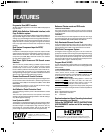
9
INSTALLING THE MONITOR
INSTALLATION PRECAUTIONS:
• Keep away from magnetic fields
The picture may be distorted if strong magnetic fields are
nearby. External speakers should be set at least 2 feet (60cm)
away from the Projection Monitor. Electric fans and other
motor driven appliances and toys may also be sources of
magnetism.
• Bright light or direct sunlight will dull the picture. Position
the Projection Monitor so that the screen faces away from
windows.
• While the Projection Monitor is operating, it is cooled by
airflow through ventilation holes in the rear and bottom.
Therefore, avoid placing it in a location where the cooling
airflow is hindered (e. g. against a wall).
• Avoid places subject to extremely high temperatures or
humidity, or to temperatures of 41°F (5°C) or lower. Also
avoid dusty places.
• If setting the Projection Monitor on a floor made of soft
material, make sure that the floor will not damaged by the
weight of the Projection Monitor.
• Do not put the Projection Monitor on a surface that is tilted,
unsteady or prone to shake or vibrate. A shaky or slanted
platform is dangerous.
• Cover shiny surfaces (floor and walls) with non reflective
materials (carpet, rugs, wallpaper, etc.).
OPERATING PRECAUTIONS
Optimum viewing distance
10 to 23 feet is the range recommended for viewing comfort.
Adjust room illumination
Excessively bright or dim lighting may strain your eyes. Draw
the curtains if necessary to shut out direct sunlight.
CARE OF YOUR PROJECTION MONITOR
DO NOT:
• Do not use strong cleansers, solvents, polishes, or chemically
treated cloths to clean the screen or cabinet.
• Do not touch or scratch the screen.
• Do not fasten or place rubber or vinyl items on the Monitor.
• Do not stick adhesive tape onto the Monitor.
• Do not put any object on the Monitor.
DO:
• Use a soft cloth to dust the screen and cabinet.
• Handle the screen with care to avoid scratches or damages.
• Ask your dealer or a Pioneer authorized service center to
clean the interior of the monitor in your area if the picture
brightness is too low even with the max. level. This may be
caused by dust buildup inside.
Condensation and picture blurring
• If the room temperature suddenly rises (or if the Projection
Monitor is moved from a cool place to a hot place),
condensation may form on the lenses resulting in picture
distortion or color fading. If this occurs, simply wait a while
(with the power switch ON) and the condensation will
disappear.
• A gradual change in temperature can prevent condensation
from forming.
INTRODUCTION
USAGE GUIDELINES & PRECAUTIONS
All phosphor-based screens can be affected by
displaying static or virtually static images for a prolonged
period of time. After-image and permanent effects on
the screen can be avoided by taking some basic
precautions. By following the recommendations listed
below, you can ensure longer and satisfactory results
from your television.
• Whenever possible, avoid continuously displaying
static or virtually static images on your Monitor
(e.g., still images, TV/video games, close-
captioning, computer programs, or other images
with static or virtually static portions).
• Avoid viewing the On-Screen Display for extended
periods from a digital tuner, DVD player, VCR and
all other components.
• Do not leave the same picture freeze-framed or
paused continuously over a long period of time
when using the still picture mode from VCR, DVD
player, or other component.
• Images which have very bright areas and very dark
areas side by side should not be displayed for a
prolonged period of time.
• When playing a game, the "GAME" mode setting
(page 52) within "Picture Adjustment Settings" is
strongly recommended. It is also recommended
that such be limited to less than two (2) hours at a
time.
• After displaying static or virtually static images
on your Monitor, it is recommended that you view
a normal moving picture in the "WIDE" or "FULL"
screen setting for three (3) times longer than the
time the static or virtually static images were
displayed.
ARB1557A_En_007_011.P65 8/8/03, 16:349


















